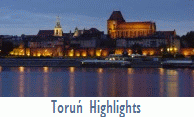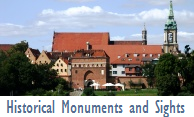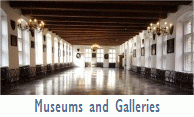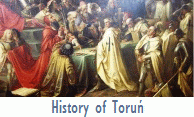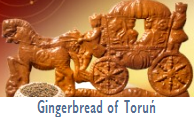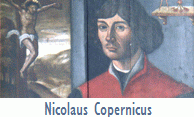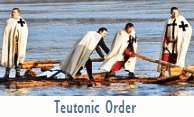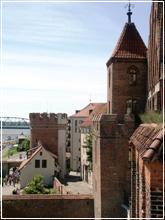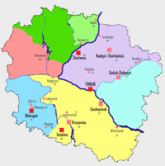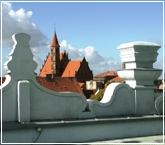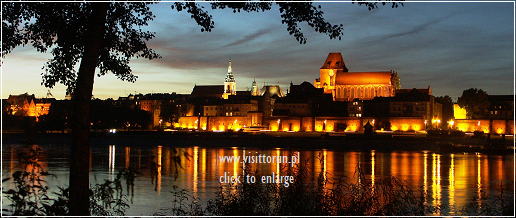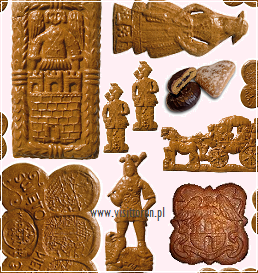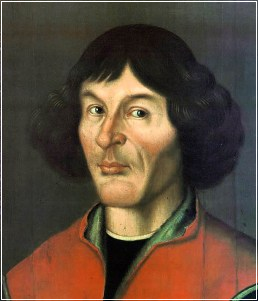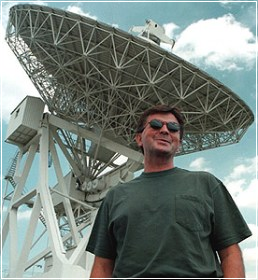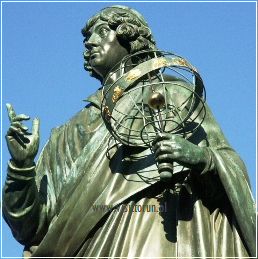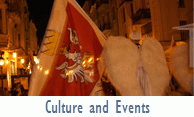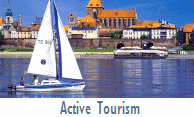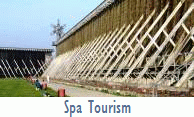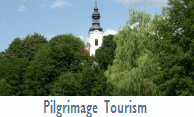|
Toruń Old City Town Hall and St. Johns' Cathedral  Suggested Reading: Suggested Reading:.bmp) Historical Monuments and Sights of Toruń here. Historical Monuments and Sights of Toruń here..bmp) Sightseeing here (guided tours, packages for groups, packages for individuals, suggestions) Sightseeing here (guided tours, packages for groups, packages for individuals, suggestions).bmp) Toruń on the UNESCO World Heritage List here Toruń on the UNESCO World Heritage List here
  Toruń Highlights: Best of Toruń here Toruń Highlights: Best of Toruń here |
 Toruń Region Must-see towns here Toruń Region Must-see towns here |
|
|
 Toruń Old Quarter Toruń Old Quarter |
|
|
|
is one big museum filled with everyday activities of its inhabitants. Here, within the Gothic city walls and moats large and small scale events are organized. Gothic towers, once built to ward off pagan attacks, are now filled with living and working people. Unique polychrome chambers are the workplace for bankers and office workers. Food lovers can eat under the Gothic and Renaissance vaults and ceilings. Tourists and burghers stumble over the bumpy pavement in medieval alleys. Toruń Old City has remained genuine. Here, in the quiet medieval parts of the city, the mysterious whispers of the ancient walls grow audible, telling strange tells of the bygone ages, while the Vistula current, indicating the former trade routes, evokes the image of the lively Hanseatic city. Here one can feel the unique atmosphere and the spirit of the monumental towers of the old city with its inhabitants turned into the stone faces of mascarons. And this is it! Days and nights are filled with street music, the patter of thousand feet and the hustle and bustle of summer cafes. In the evenings and at nights, stu-dents of the local Alma Mater Thoruniensis swarm in beer houses and wine bars, located in Gothic cellars just as in the Middle Ages and open until the last customer crawls out.
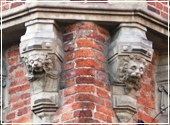 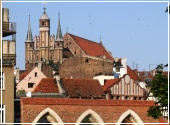
|
|
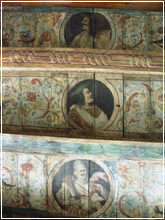
Renaissance ceiling polychromies at 17 Rynek Staromiejski (Old City Market Square) are one of the numerous such a valuable historical paintings in Toruń Gothic Guardhouse Tower and Bridge Gate
|
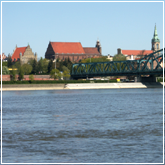 The whole of Toruń Old Quarter is a world-class historic monument. Its layout has remained unchanged since the Middle Ages and today we can still admire the superb architectural complex. The mid-13th century urban solutions seem to have been so well-thought of that there has been no need to rebuild them ever since. The whole of Toruń Old Quarter is a world-class historic monument. Its layout has remained unchanged since the Middle Ages and today we can still admire the superb architectural complex. The mid-13th century urban solutions seem to have been so well-thought of that there has been no need to rebuild them ever since. The unique medieval brick Gothic architecture (see the chapter: Historic Architecture of Toruń here) comprises numerous burgher and merchant residences (including Copernicus House), the impressive Old City Town Hall, monumental churches (including the cathedral with the largest medieval bell in Poland), the never-ending city walls, gates, towers (including the famous Leaning Tower) and the ruins of the Teutonic Castle. There are some 550 monuments altogether (360 of which are the high class) here, i.e. within the Old Quarter area of 32 ha, which brings Toruń to the fore in respect of the number of monuments and architectonic significance in Poland. Five of them are world-class, which, on a par with Gdańsk, won Toruń the title of the second city with the greatest number of monuments after Krakow. Moreover, the very Old and the New Cities, as well as the Teutonic Castle (the Old Quarter), deserve to be called world-class themselves.
 Toruń lies on the border Toruń lies on the border |
|
|
of three neighbouring areas: the Chełmno Land (part of Pomerania) in the north, Kuiavia in the south and the Dobrzyń Land in the east. The city is therefore the excellent base for exploring the attractive region. The region offers the opportunity to visit medieval castles, including Teutonic fortresses, a number of cities, superb architectural monuments, strongholds, excavations, archeological sites, picturesque landscapes, nature phenomena, lake districts and forests which provide excellent conditions for holiday tourism, as well as villages with surviving construction and folk relics.
A longer stay in Toruń can guarantee visiting popular and attractive places in a short period of time. The top must-see spots include Golub-Dobrzyń (42 km of Toruń), Chełmno (45 km), Ciechocinek (24 km), Kruszwica (52 km) and Strzelno (56 km). More remotely located tourist attractions are Biskupin (92 km), Grudziądz (65 km), Brodnica (65 km) and Inowrocław (35 km). The visit to the each one of major sights in the region is practically possible in one day.
 Suggested Reading: Suggested Reading:
|
|
Map of the most attractive tourist localities in the region of Toruń. Click to enlarge.
|
 Best of Toruń Best of Toruń |
|
|
Toruń is one of the few cities in Poland which did not suffer considerable war damage during World War II. It boasts not only excellent surviving architecture but also the spirit of bygone medieval times, which often makes it one of the most favourite tourist destinations. It is, for this reason, also included on the UNESCO World Heritage List.
The list of Toruń tourist hits – its biggest attractions presented below – provides a brief description of the ‘Gothic pearl’ and may serve as a starting point for getting to know the city.
|
 Best of Toruń: Vistulian Panorama Best of Toruń: Vistulian Panorama |
|
|
The view of the Old Quarter as seen from the south bank of the river (Kępa Bazarowa islet, a forest reservation unique for its central location in the city) is among the most beautiful city panoramas. It has always inspired painters, poets and raftsmen floating their rafts down the Vistula. It is, at the same time, the most popular view of Toruń, stunningly illuminated at night.
|
 Best of Toruń: Toruń Gingerbread Best of Toruń: Toruń Gingerbread |
|
Toruń gingerbread has long been the most famous gingerbread in the world. The plain or sophisticatedly shaped cakes, the former known as "Catherines", are the tradition, heritage and symbol of Toruń, as well as an indispensable souvenir of the city. Their peculiarity lies not only in their taste, but also in their figural forms. The beautiful richly ornamental wooden baking tray moulds are masterpieces of the high-level woodcarving art themselves, which is well-illustrated by the surviving examples in the City Hall museum or on the permanent exhibition "The world of Toruń gingerbread".
• More information on Toruń gingerbread available here. |
|
|
 Best of Toruń: Nicolaus Copernicus Tradition Best of Toruń: Nicolaus Copernicus Tradition |
The tradition relating to the greatest and most famous astronomer of all time… born in Toruń, who is said to have “held the Sun and moved the Earth”, is still alive in his hometown. His spirit seems to pervade the field of science he developed, motivating other eminent scientists in the history of Toruń to follow his example. These include Professor Władysław Dziewulski, a co-founder and professor at the Nicolaus Copernicus University, as well as the first director of Toruń Astronomic Observatory in 1945-1960 who also initiated the study of astrophysics and star astronomy in Poland; and Professor Wilhelmina Iwanowska, a co-founder of astronomical science at Toruń university, a vice-President of International Astronomical Union and the Freeman of the City of Toruń.
• More information on Nicolaus Copernicus available here.
Born in 1946, Aleksander Wolszczan is Toruń university graduate and the greatest living astronomer in the world. USA-based since 1982, he was working in Toruń since 1994. In 1990, while doing some academic research in Puerto Rico using the greatest radio telescope in the world, Wolszczan discovered Pulsar PSR B1257+12; in 1992 he officially announced the theory of a planetary system around the pulsar, which partially met with skepticism in the scientific world; in 1994, in the course of further research Wolszczan published data confirming the existence of the newly discovered non-solar planetary system; in 1992 he was awarded the Prize of the Foundation for Polish Science.
Walking in the footsteps of Nicolaus Copernicus should begin at his birthplace: red brick Copernicus family house. This should be followed by visiting Copernicus Chapel in St. Johns’ Cathedral, housing a number of Copernicus-related memorabilia such as the baptismal font where he was baptized, a commemorative plaque from 1589 - his first memorial, or a marble bust dating from 1766, his oldest monument. However, the most famous Nicolaus Copernicus monument is located centrally – in the Old City Market Square, the most important part of the city. The last places commemorating the great astronomer include the Astronomical Observatory under the auspices of Nicolaus Copernicus University (with one of the biggest radio telescopes in the world, potent enough to locate a mobile phone on the Moon with the accuracy of several metres) and:
|
|
|
 Best of Toruń: Nicolaus Copernicus University Best of Toruń: Nicolaus Copernicus University |
|
Toruń University is the biggest and oldest academic institution in the north of Poland, which received high appraisal for its Departament of Law and Administration as well as the Departament of Physics and Astronomy. It is also the only university in Poland employing world-famous restorers in the Department of Fine Arts. The university is made up of 16 departments and a number of other organizational units which accommodate over 32 thousand students. It employs over 4.4 thousand people, including over 2.2 thousand academic workers.
The university is also the only secular academic institution in Poland which hosted Pope John Paul II.
• More information on the university available here.
• More information on Nicolaus Copernicus here.• More information on University Museum here. |
|
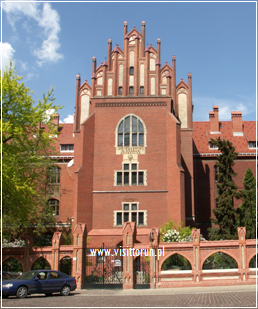 |
 Best of Toruń: Gothic Best of Toruń: Gothic |
In Poland Toruń is second to Krakow in respect of the unique and original large medieval architectural complex. It is also the first such city in the north of Poland, which is why it is often referred to as the Krakow of the North or Little Krakow. The complex has survived largely intact since the Copernicus time and can boast the greatest number of world-class monuments and the greatest number of monuments in total. The Gothic burgher architecture with the Old City Town Hall, the St. George Guild House, numerous tenement houses, granaries, defense walls, towers and gates, as well as some other secular buildings, is original, unique and the biggest in Poland.
• More information on Toruń monuments available here
• More information on Toruń historic architecture available here |
|
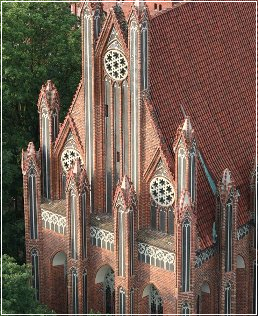 |
 Best of Toruń: Old City Town Hall Best of Toruń: Old City Town Hall |
Old City Town Hall is the most impressive building of its kind in Poland and one of the biggest in the world. Its tower dating from 1274 is the oldest city hall tower in this part of Europe. Toruń City Hall is among the most outstanding achievements of burgher architecture in Europe. Its perfect and and well-balanced proportions, together with the rich and artistic interior furnishing reflect the architectural artistry and an excellent taste of Toruń patriciate who considered it their pride. It was the manifestation of the economic power of Toruń, the former Hanseatic trade emporium, and the most splendid secular building in the city, the venue for momentous occasions and grand ceremonies, as well as the residence of the Kings of Poland who particularly frequently paid visits to Toruń.
Today the building houses the District Museum with its collections that perfectly reflect the former glory of the city and its high artistic culture.
• More information on the Old City Town Hall available here.
|
|
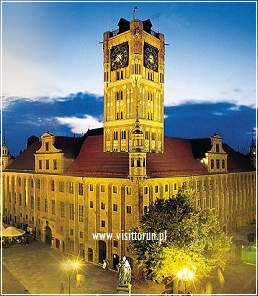 |
 Best of Toruń: St. Johns’ Cathedral Best of Toruń: St. Johns’ Cathedral |
St. Jonh the Baptist and St. John Evangelist are the patrons of the red brick Gothic high-hall building with “Tuba Dei”, the second seven-ton-heavy bell in Poland, numerous Copernicus-related memorabilia, the font where the great astronomer took baptism, the heart of King Jan Olbracht (John Albert) and the first attic over the north galilees in Poland. The church, one of the oldest and one of the three biggest buildings of its kind in the north of Poland, boats many valuable works of art, particularly those of the Gothic period. It witnessed numerous ceremonies, including those dignified by the Kings of Poland and was at the centre of attention of the powerful Toruń patriciate and gentry, who took it under their care and endowed chapels, epitaphs, and gravestones surviving till today.
• More information on the cathedral available here
|
|
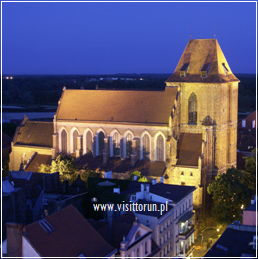 |
 Best of Toruń: Tuba Dei Bell Best of Toruń: Tuba Dei Bell |
|
|
Since 1500 St. Johns’ Cathedral tower has accommodated an unusual bell - Tuba Dei (God’s Trumpet). Its peculiarity lies in the fact that it is not only the biggest medieval bell in Poland, but also one of the biggest Polish bells in general (until recently the second biggest). Before casting the famous Sigismund Bell in Krakow (1521), Tuba Dei had been recognized as the biggest in the Kingdom of Poland.
Today it is no small attraction for tourists, especially when it sounds, which takes place several times a year. Not once in its over 500-year-old history had it been subject to destruction or plunder during war.
• More information available here.
|
|
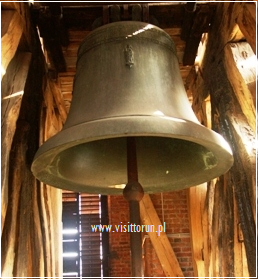 |
 Best of Toruń: Church of the Blessed Virgin Mary (Our Lady Church) Best of Toruń: Church of the Blessed Virgin Mary (Our Lady Church) |
One of the most outstanding achievements of Gothic church architecture in Poland and among the three biggest churches in the north of Poland. The slender monumental post-Franciscan church towering over the north part of the Old City boasts a number of valuable artistic and historic works of art, such as the Gothic stalls, mural polychromes, a large Renaissance organ - the oldest and most beautiful in Poland, epitaphs and the mausoleum of Princess Anna Vasa. During the Renaissance the post-monastic buildings adjacent to the church accommodated the famous Academic Gymnasium marking the intellectual level of Royal Prussia.
• More information on St. Mary’s Church available here.
|
|
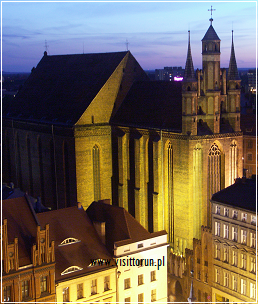 |
| Best of Toruń: St. James’s Church |
St. James's Church is another example of an excellent Gothic church building. It is the smallest such building in Toruń and it is distinctive for its architectural features which were rare in Poland and characteristic of West European medieval church buildings. Some consider it the most balanced and the most beautiful Toruń church.
Its most valuable interior furnishings include the rich medieval mural polychromes and numerous Gothic works of art, such as the Tree of Life, the painting of the Passion of Christ, a number of statues and sculptures and the Renaissance organ front.
• More information on St. James’s Church available here
|
|
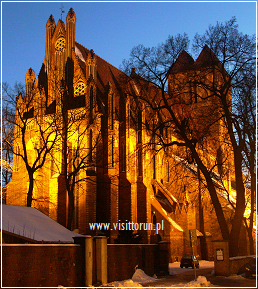 |
 Best of Toruń: The Passion of Christ Best of Toruń: The Passion of Christ |
A large 274 x 221 cm (9 x 7.3 feet) painting presenting 22 scenes of the Passion of Christ against landscape and late Gothic architecture imitating that of Jerusalem can be found in the presbytery of St. James’s Church. It is a precious and fascinating example of Gothic panel painting, made after 1480 in Toruń workshop. Formerly it belonged to Toruń St. Nicholas Church, dismantled in the 19th century. All the scenes – an evangelical lecture of a moralizing character – are characteristic of Dominican teachings. The sacral scenes are accompanied here by the genre scenes which show, for example, a shepherd with oxen, hunting, women with baskets, and a figure of a person in a boat. At the bottom and in the middle of the painting, there is a kneeling figure of its founder, presented against a background of a wall. It has been partly influenced by the Netherlandic art, while its creator in all probability referred to Hans Memling’s Passion of 1480 in Turin.
|
|
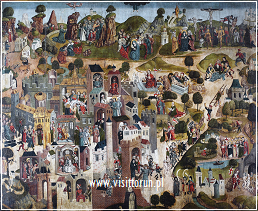 |
 Best of Toruń: The Leaning Tower Best of Toruń: The Leaning Tower |
Formerly part of the city fortifications with 54 other fortified towers. Contrary to what the legends say, its tilt is the result of the instability of the clay ground. Surviving in the line of the city walls, it is among the biggest wonders and tourist attractions in Toruń today. It is another symbol of the city, most frequently photographed by tourists.
• More information on the Leaning Tower available here
|
|
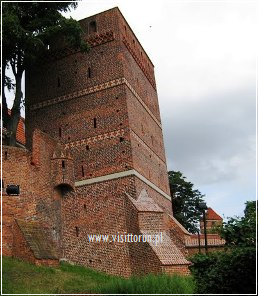 |
 Best of Toruń: Artus House (Artus Court) Best of Toruń: Artus House (Artus Court) |
Artus Court in Toruń and Gdańsk are the only buildings of their kind in the world today. Even though the present-day building dates back to the 19th century, its structure has been modeled on that from 1386. Few people realize that Toruń Artus Court was the first building of its kind erected in the Teutonic State. It was the seat of St. George Brotherhood, an exclusive association of merchants and rich Toruń patricians, active in Toruń in 1311-1842. It was the venue for a number of important meetings, including those of a political character, the most important of which was signing the Second Peace Treaty of Toruń in 1466 concluding the Thirteen Years’ War and putting an end to the Teutonic State in its former shape.
• More information on Artus Court available here |
|
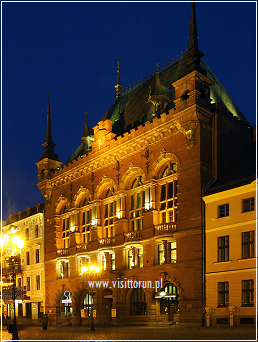 |
 Best of Toruń: The Star Residence Best of Toruń: The Star Residence |
The Star Residence is among the most imposing and best preserved Baroque patrician houses in central and northern Europe and one of the six world-class monuments in Toruń. Before its reconstruction in the Baroque style, it was the property of renowned Filippo Buonaccorsi, in 1496, known as Callimachus, an outstanding humanist and royal counselor at Wawel court in Krakow.
Today the building is the best example of a typical Toruń Baroque patrician tenement house with the interior and furnishings typical of the south Baltic coast. These include the spiral staircase with Minerva and a lion, polychrome structural ceilings, antique woodwork and the splendid, richly ornamental floral façade.
• More information on the Star Residence available here |
|
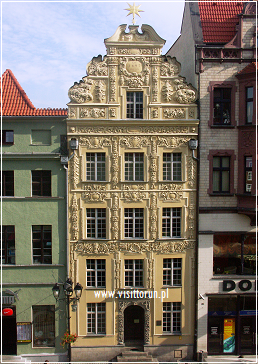 |
 Best of Toruń: Medieval patrician houses Best of Toruń: Medieval patrician houses |
Toruń can boast the greatest number of well-preserved medieval burgher tenements, dating back mainly to the 14th and 15th centuries. There are a few hundred houses with more or less discernible Gothic features, unique on both the national and European scale. They are among the best preserved buildings of their kind and well illustrate a typical house in an old affluent medieval city. Despite numerous reconstructions in the 19th century, many tenements have retained their original Gothic interior layout today, together with the precious mural polychromes, polychrome vaults and ceilings, and facades. Toruń has the greatest number of surviving murals in secular homes. Beside Toruń, they can be found in some of Warsaw tenements, two in Gdańsk City Hall and one on the façade of a tenement in Wrocław.
Toruń patrician tenements and their rich ornamentation manifest the former affluence of the city and the artistic aspirations of its inhabitants shaped by West-European patterns.
• More information on Toruń patrician tenements available here
|
|
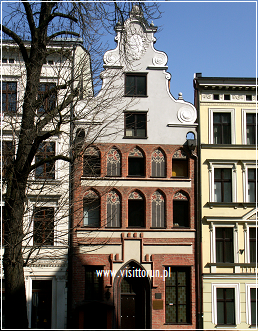 |
 Best of Toruń: Mural and ceiling polychromes Best of Toruń: Mural and ceiling polychromes |
|
Toruń is undoubtedly one of the few cities which can boast surviving mural and ceiling polychromes both in the secular and church buildings. They are unique both for their number and quality. Most Gothic polychromes have survived in medieval Toruń churches and, extremely rarely, in patrician houses. They are, at the same time, the oldest examples of Gothic polychromes in burgher residences in Poland. Vigorous Toruń studios produced a number of outstanding artworks. In the Renaissance and Mannerism, the successive periods of cultural development of Toruń, plychromes were largely produced in private homes, which proved the good taste and financial capacity of Toruń burghers.
Polychrome ceilings in Toruń patrician tenements are unique for their number despite numerous cataclysms the city suffered in the 17th and 18th centuries and 19th century reconstructions.
|
|
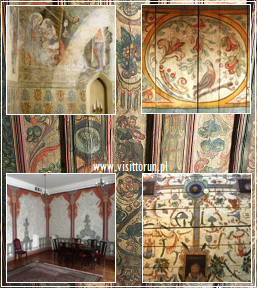 |
 Best of Toruń: Granaries Best of Toruń: Granaries |
Toruń, as one of the principal trade centres and the most important Vistula harbour in the 13th and 14th centuries, developed sophisticated architectural designs employed not only in churches, public buildings, fortifications and residences, but also in granaries. As early as the beginning of the 14th century Toruń merchant tenements were higher and had larger storage facilities (the so-called granary houses). The number of individual granaries in the 14th century totaled about 30. They were typically located within the city walls rather than immediately beside the river. Apart from these, there were also the Teutonic granaries.
The surviving Toruń granaries are among the oldest and most valuable in Poland, well illustrating the architectural forms and ornamental details of their time. They also mark Toruń membership in the Hanseatic League and its active involvement in the early long-distance trade.
• More information on the granaries available here
|
|
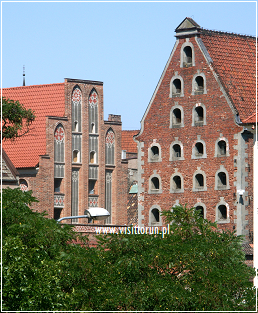 |
 Best of Toruń: Museums Best of Toruń: Museums |
Toruń District Museum (one of the biggest in the north of Poland), holding exhibitions in several departments, offers the biggest high-class collections of old Toruń art and unique Pomeranian, Polish and world masterpieces. The biggest collections are on show in the Old City Town Hall, housing as many as 9 exhibitions. The most valuable include the unique medieval Judical Hall, Gothic stained glass and religious sculptures, the Renaissance portraits of Toruń patriciate, the oldest pictorial guide to Kings of Poland painted in their lifetime, a rich collection of Toruń intarsia furniture, the goldsmithery collection with the unique treasure of Skrwilno and the gallery of Polish painting of the mid-18th century onwards, including works by Bacciarelli, Smuglewicz, Gerson, Gierymski brothers, Witkiewicz, Malczewski, Matejko and many others.
Two medieval Hanseatic tenements accommodate Copernicus House, while the exquisite Star Residence contains not only the marvelous interior furnishing of a typical Toruń patrician residence house, but also the collections of the Far-Eastern art with the oldest Chinese artwork of the Han dynasty.
Equally interesting are also Tony Halik Travellers’ Museum, the Museum of Ethnography, the University Museum, Toruń Fort No. 4, the Centre For Modern Art, etc.
• More information on Toruń Museums available here
|
|
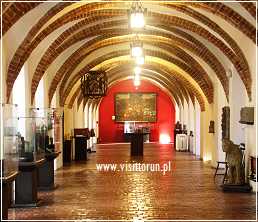 |
 Best of Toruń: Pictorial Guide to the Kings of Poland Best of Toruń: Pictorial Guide to the Kings of Poland |
|
The Toruń set of 24 portraits of Polish kings, exhibited in the Royal Hall of the Old City Town Hall is a valuable collection of portraits of Polish monarchs. The 13 oldest portraits were painted during the lifetime of King Władysław IV Vasa, on the foundation of Toruń Council, probably before the year 1645 - to celebrate the meeting of Charitativum Colloquium organized at the initiative of that king.
The pictorial guide to the Polish kings in Toruń is the oldest one in Poland.
|
|
 |
 Best of Toruń: Stained Glass Best of Toruń: Stained Glass |
In the Middle Ages Toruń was one of the most important stained-glass production centres. Toruń’s stained-glass producers were widely-known for their skills and exported their products even as far as Courland. The surviving stained-glass fragments from the presbytery in St. Johns’ and St. Mary’s Churches and above all the precious collection of figurative stained glass from St. Nicholas Church suggest that the 14th century saw the flowering of the high quality stained-glass art in Toruń. All of them are stored at the District Museum, which houses the largest collection of stained glass in Poland. The collection encompasses stained glass from non-existent St. Nicholas’s Church and St. Mary’s Church in Toruń, and the parish church in Chełmno.
|
|
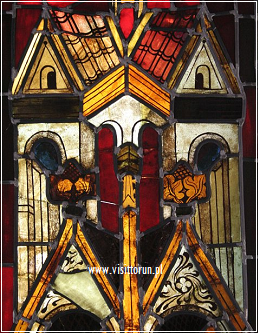 |
 Best of Toruń: The Skrwilno Treasure Best of Toruń: The Skrwilno Treasure |
The set of Mannerist and Renaissance jewellery of the 16th and 17th centuries is an uncommon treasure exhibited in the District Museum. The objects constitute a precious collection of decorative handicraft articles of high artistic quality. The exceptional significance of this collection of objects derives from the fact that it was the possession of a particular family, a household; thus the treasure becomes a kind of document, presenting the level of wealth of a representative of nobility from the central part of the country in the first half of the 17th century.
• More about the Skrwilno Treasure here
|
|
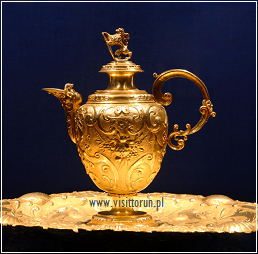 |
 Best of Toruń: Intarsia woodwork (Toruń furniture) Best of Toruń: Intarsia woodwork (Toruń furniture) |
|
The Toruń intarsia woodwork reached its peak in the 18th century, though the technique had been used in the city since the second half of the 16th century. Around 1730 it became the dominant decorative technique, applied to nearly all elements of patrician interior furnishings, such as hall wardrobes, hanging cabinets, longcase clocks, chests, boxes and doors, as well as to those with a representative function, for example, the portals, doors and panels in the Old City Hall and churches. This high quality artistic furnishing earned the name of Toruń furniture. Produced in large quantities, the Baroque and Rococo furniture gained enormous popularity, making Toruń artisans widely recognized. The year 1793, which saw the incorporation of Toruń into German Prussia, irretrievably brought an end to the golden age of Toruń furniture making.
|
|
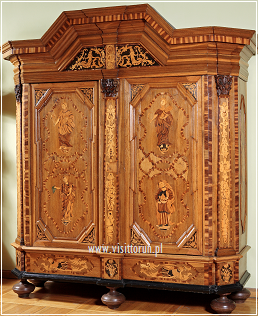 |
 Best of Toruń: Gothic Castles Best of Toruń: Gothic Castles |
Rarely can a Polish city boast more than one castle located within its boundaries. In Toruń there were two, representative of two separate countries in the past and currently in ruins. These are the mid-13th century Teutonic Castle – the headquarters of the Commander on the right Vistula bank and early 13th century Polish Dybów Castle – the headquarters of the royal district governors (starost), on the left river bank, i.e. within the territory of the Kingdom of Poland.
Toruń, as a Teutonic border city and the so-called ‘Gate to Prussia’, was located the furthest south in the Teutonic State and was the first and biggest Prussian city to be encountered while traveling from the Kingom of Poland. It was thus the natural meeting point and an arena for a number of political events in the history of Polish-Teutonic relations. Its strategic position led to erecting two important watchtowers here, each belonging to a different state.
Besides them, the area boasts the castles in Zamek Bierzgłowski and Złotoria, the latter currently in ruins.
• More information on the castles available here
|
|
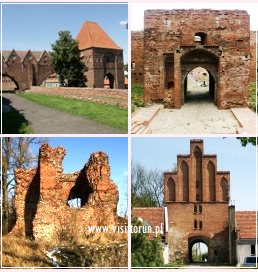 |
 Best of Toruń: Toruń Fortress Best of Toruń: Toruń Fortress |
Nearly 150 surviving structures comprising one of the biggest 19th-century fortresses in Europe built by the Prussians are open to visitors today. Among other things, the fortress includes 15 large forts, well preserved and overwhelming in their size.
The black tourist trail is designed to take visitors to the surviving structures of Toruń fortress.
• More information available here
|
|
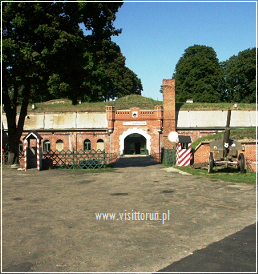 |
 Best of Toruń: Planetarium Best of Toruń: Planetarium |
Copernican Toruń would by no means do without a planetarium, the most up-to-date and popular institution of its kind in Poland. Its modern facilities and special effects guarantee an unforgettable show. Here one can see a starry night in the middle of the day, experience a space flight to distant planets, fly through Saturn rings or look into the space from the perspective of other planets.
• More information on the Planetarium available here
|
|
 |
 Best of Toruń: Centre for Contemporary Art Best of Toruń: Centre for Contemporary Art |
Toruń Centre for Modern Art "Znaki Czasu" is the first newly erected modern art museum since 1939. Its construction won the 2nd place on the Radio Channel 3 plebiscite for the most important cultural event in Poland in 2008. Aspiring to the role of the contemporary centre of Toruń’s artistic life, the centre aims to develop, popularize and promote modern art. These objectives will be met through creating regional art collections, organizing exhibitions, issuing publications and engaging in educational activities.
• More information on the centre available here
|
|
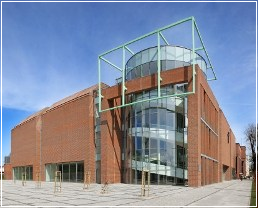 |
 Best of Toruń: Museum and Park of Ethnography Best of Toruń: Museum and Park of Ethnography |
Museum of Ethnography located in the very centre of Toruń, adjacent to the Old City, offers the possibility to become familiar with the old Polish countryside (especially from the regions of Kuiavia, Kashubia and the Tuchola Forest) and its traditions. It comprises folk architecture with fully-equipped farmsteads, a post mill, a water mil, a forge and a fire station. The museum is one of the three independent and biggest museums of their kind in Poland. Its collection spans the whole of the folk culture in the north of Poland and the fisherman’s tradition in Poland.
Another open-air museum is located outside the city centre in Kaszczorek. Its exhibition relates to fishing and rafting traditions on the Vistula River.
• More information on Museum of Ethnography and park museums available here
|
|
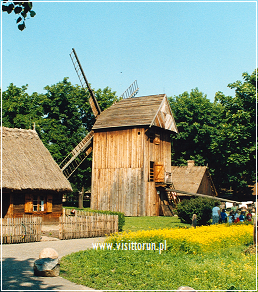 |
 Best of Toruń: Bydgoskie Przedmieście District Best of Toruń: Bydgoskie Przedmieście District |
|
Bydgoskie Przedmieście District (or Bydgoskie Suburb; suburb as compared to the Old Quarter) is located to the west of the city centre, owes its unique character to its exceptional location on the Vistula escarpment, the English-style park of 1817, the abundance of greenery and a variety of architectural styles. Its present-day architecture dates back to the 19th and early 20th centuries and comprises Classicist, Eclectic, Art Nouveau, and neo-Gothic tenements, as well as half-timbered houses. The buildings are characterized by corner turrets, ornamented tops, half-timbered walls, the multitude of details and decorations. Bydgoskie Suburb was an exclusive and privileged district of the city attracting office workers, officers and freelancers. A large number of well-known and significant people resided here. In the interwar period the so-called ‘Zofijówka’, a pension run by Kazimiera Żuławska, hosted such artists as Stanisław Przybyszewski, Tymon Niesiołowski, Stanisław Ignacy Witkiewicz, Juliusz Osterwa and others. Here the first Polish Oficer Naval Academy was established.
• More information on the district available here |
|
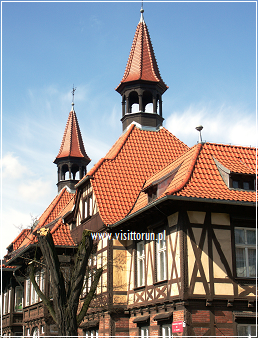 |
 Best of Toruń: Philadelphia Boulevard Best of Toruń: Philadelphia Boulevard |
The Vistula boulevard running between the mediaeval city walls and the river is among people’s most favourite walking areas. It covers the area previously occupied by the harbour, operating from the foundation of the city in the 13th century until the 1970s. In 1976 the boulevard received its present-day name in honour of Philadelphia, one of Toruń’s sister cities. The main part of the old harbour, situated between the Convent Gate and the Sailors Gate, accommodated harbour facilities, a 200-metre-long wooden unloading ramp, a crane, commodity warehouses and others. In 1585 the whole area was paved. The former harbour was teeming with life, filled with sailors and merchants bustling about dozens of docked ships from where the overseas commodities were unloaded and transported to huge granaries, cellars and warehouses. In the Middle Ages Toruń harbour hosted seagoing ships. According the 14th century sources, there were as many as 172 Toruń merchants involved in the great sea trade.
|
|
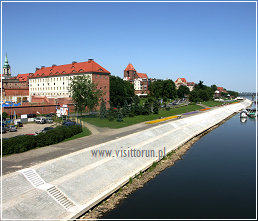 |
 Best of Toruń: Kępa Bazarowa Islet Best of Toruń: Kępa Bazarowa Islet |
Kępa Bazarowa is a unique centrally located islet with the area of 70 ha (173 acres), over 2.5 km (1.5 miles) long and over 400 m (1313 feet) wide. Half of its surface (32.4 ha; 80 acres) is covered by a nature reservation, a riverine forest – the remains of the riparian forests in the Valley of Toruń. Here, on a modest viewing platform, the most popular and fascinating panorama of Toruń Old City can be seen. The place also bears historical significance. On February 1 it witnessed signing the First Peace Treaty of Toruń, concluding the so-called Great War between Poland and the Teutonic State. Its name dates back to the 13th century and originates from merchants stopping over here.
• More information on Kępa Bazarowa available here
|
|
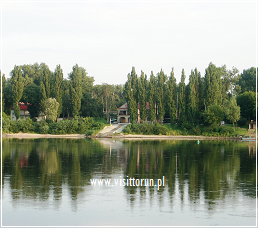 |
 Best of Toruń: Greenery Best of Toruń: Greenery |
| Toruń is remarkable for its greenery. Numerous urban parks, street greenery, extensive forests and valleys along the river make it a beauty spot. An amazing place of exceptional natural beauty is the centrally located forest reservation on Kępa Bazarowa islet, situated on the left bank of the Vistula opposite the Old Quarter. The areas south, east and north of Toruń are part of a wider protected landscape. The southern (Kuiavian) part of the city is covered by one of the biggest protected complexes of inland dunes in Poland, known as “The Dune Area to the South of Toruń”. The northern part with historic Barbarka, covered by forest, is the leisure hinterland of Toruń offering hiking and cycling trails, as well as the famous regional trail of natural and educational value running through Bielany, Barbarka, Przysiek and Bydgoskie District. |
|
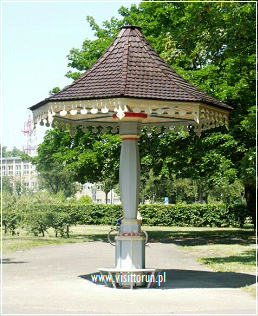 |
 Best of Toruń: Barbarka District Best of Toruń: Barbarka District |
Located north-west of the city limits, Barbarka is an over 700-year-old forest hamlet with a rich history and many places of interest. However, it is not only historically significant; it offers also a number of leisure facilities and is an ideal destination for all nature lovers.
In the medieval times Barbarka was the shrine of St. Barbara, who, according to a legend, was to reveal herself to a hermit. It soon became a pilgrimage site and received a visit from, for example, Polish King Zygmunt Stary (Sigismund the Elder) who in 1521 came to see the local chapel and the Gothic figure of St. Barbara. For a few hundred years Barbarka owned a mill. During World War II Barbarka witnessed mass executions of Toruń intelligentsia by Germans.
Today it is a large interesting and full-fledged leisure spot, picturesquely located near a pond in the forest.
• More information available here
|
|
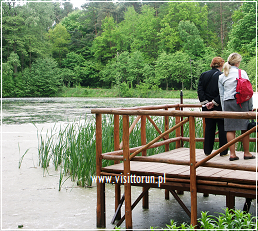 |
 Best of Toruń: Theatres Best of Toruń: Theatres |
Apart from the unique architectural design, Toruń theatres offer diverse programs and can boast long historical traditions reaching as far back as the 16th century, which was when the theatres of Academic Gymnasium and the Jesuit College staged their performances in Arthus House.
The present-day building of Wilam Horzyca Theatre was erected in 1904 by a famous Vienna company owned by F. Fellner and H. Helmer. Its architecture combines the elements of the Eclectic, Baroque and Art Nouveau styles. Since 1991, the theatre has been organising “Kontakt” festivals.
Baj Pomorski Theatre is located in an unusual fairytale building with a unique facade, resembling a large wooden wardrobe at the entrance.
• More information on Toruń theatres available here
|
|
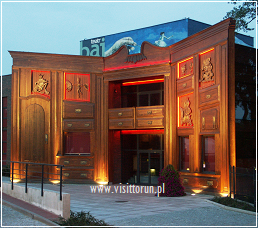 |
 Best of Toruń: Uncommon avenues Best of Toruń: Uncommon avenues |
Toruń Walk of Merchants' Marks (Aleja Gmerków) is located in Żeglarska Street, formerly a part of the Royal Avenue (Via Regia) and includes 25 marks of medieval Toruń Hanseatic merchants residing. Only a small number of medieval merchant families involved in the great international sea trade are listed here. Their activities were not confined only to their membership in the Hanseatic League but included also other areas of life. More information available here.
Another Toruń attraction is the Gingerbread Walk of Fame (Piernikowa Aleja Gwiazd) located in the centre of the Old City, in front of Artus Court. Each year two celebrities distinguished by their contributions to the city reveal their autographs here.
• More information available here.Walk of the Hanseatic Cities' Crests is routed in the surface of the main streets of the Old Quarter, linking the Old Town Market Square with the New Town Market Square: Szeroka (Broadway) Street and Królowej Jadwigi (Queen Hedwig) Street. There are presented 30 European cities, with which Toruń maintained close trade relations as one of the biggest commercial centres of Europe
More information available here.
|
|
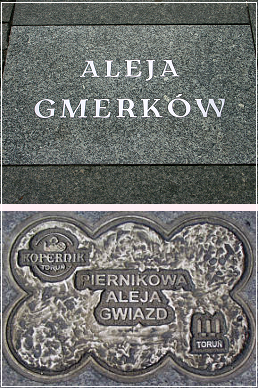 |
 Best of Toruń: Significant cultural events Best of Toruń: Significant cultural events |
A cultural climate of a city can be defined by a number of cultural events organized there. The city earned its reputation as an important cultural centre for such large-scale cultural events as Toruń Festival of Science and Art (April), International Theatre Festival "Kontakt" (May), Probaltica Festival of Music and Art from the Baltic States (May), the international Ecumenical Christian Music Festival "Song of Songs" (June), International Summer Festival "Toruń – Music and Architecture" (summer), summer movie shows (July) and practically hundreds of other events.
• The calendar of annual cultural events available here |
|
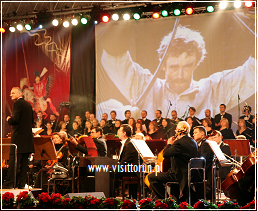 |
|
Curent local weather in Toruń  | temp. 7.3° C |
|
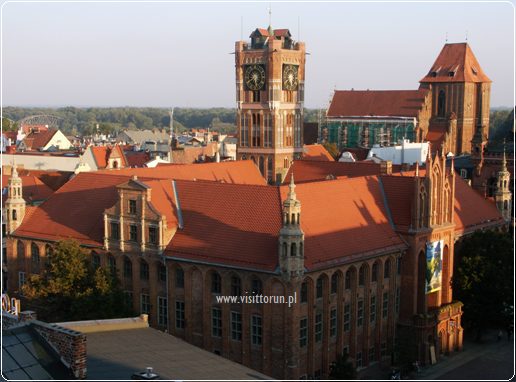
 Suggested Reading:
Suggested Reading: The whole of Toruń Old Quarter is a world-class historic monument. Its layout has remained unchanged since the Middle Ages and today we can still admire the superb architectural complex. The mid-13th century urban solutions seem to have been so well-thought of that there has been no need to rebuild them ever since.
The whole of Toruń Old Quarter is a world-class historic monument. Its layout has remained unchanged since the Middle Ages and today we can still admire the superb architectural complex. The mid-13th century urban solutions seem to have been so well-thought of that there has been no need to rebuild them ever since. 



